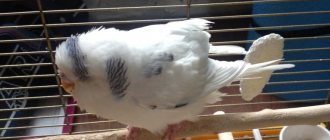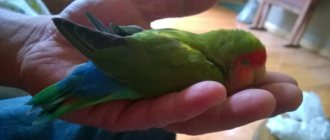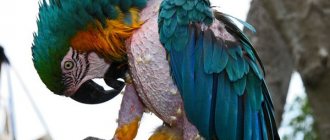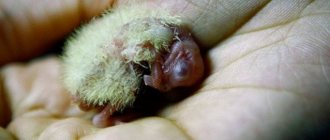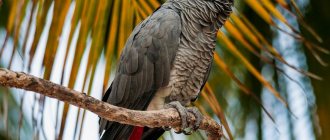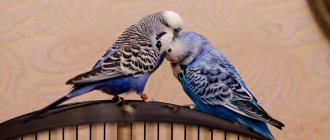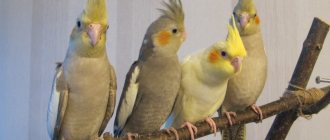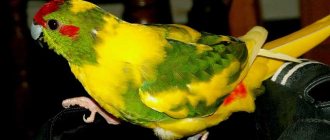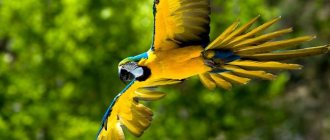The first description of the necklace parrot was given by the Italian-Austrian naturalist Giovanni Antonio Scopoli. He liked the soft green birds, so he decided to name them after the famous zoologist Wilhelm Kramer. Subsequently, in addition to this name, the birds of this species acquired another name - Indian ring-necked parrots.
For its intelligence and beauty, the necklace parrot earned the love of Indian emperors. For a long time, images of this bird decorated the walls of the houses of honorable citizens. Only wealthy people could afford this type of bird. At that time, scientists did not yet know how long necklace parrots lived at home, but by their appearance they could determine the status of the owner. A respectful attitude towards this species of bird has been preserved in Asia to this day. Parrots are still respected here and protected from attacks by farmers.
Appearance of the bird
The necklace parrot is of medium size. The smallest adults reach 30 centimeters in length, and the largest - 50. Birds of this species have a very long tail, it takes up about half of the total length. The longest tail feathers are bright blue, the rest of the plumage is green. The birds got their name from their unique decoration: the parrot appears to be wearing a colorful necklace on its neck.
The birds have a slender body, so their weight does not exceed 140 grams. The wings are pointed and long, the red-black beak is large and round in shape. The legs are short and very weak, so the bird uses its beak as additional support. The color of the necklace parrot can be different: green, white, yellow or blue. These colors appeared as a result of the work of breeders.
Preparing the grain mixture
The main food for necklace parrots is grain. But they need to be fed not with some particular species, but with a prepared mixture. As a percentage, half of the total volume should be millet. It comes in different varieties, but necklace parrots prefer white, which is larger than red or gray. However, red millet contains more useful vitamin A. You can use canary seed as a base, which is no less useful.
Approximately 30% of the total mixture is oats. The remaining 20% is sunflower seeds, rapeseed, lettuce and wild plants such as plantain.
It is better not to include corn in the grain mixture, since when dry it is very hard and is not particularly attractive to your pet. But the beneficial substances contained in this plant (vitamin B, protein, phosphorus, mineral salts) are necessary for the health of the parrot.
Habitat
The main regions of residence of this type of parrot are considered to be South Asia and East Africa. The birds also live in Australia and Madagascar, where they were brought to increase their numbers. Kramer's necklace parrot prefers to live in forests. Birds of this species not only rest on trees, but also set up their own homes, where they later breed their offspring. These parrots also choose housing at altitude because it is convenient for them to take off from here. Most of their lives they fly, and do not move on the ground like some of their brothers. Kramer's necklace parrot moves luxuriously in the air: it covers long distances in the shortest period of time, thanks to which it can find food not only near its home, but also at a distance from it. Recently, this species of birds is increasingly leaving their homes to settle down near people. This proximity allows birds not to be afraid of predators and snakes, and also not to be afraid of hunger.
Favorite treats
Feel free to give raspberries, strawberries and other berries to your parrot. They are all very helpful. Ozherelovye also love chokeberry and grapes. In winter, you can replace fresh fruits and berries with dried ones. Just before feeding, they need to be kept in water for some time so that they become soft.
Of the nuts, preference is given to walnuts. Parrots love peanuts and hazelnuts. If you teach your pet to eat chestnuts and acorns, you will get some savings on your budget, since you can prepare them yourself. All of the listed hard fruits should be crushed.
It is best not to include meat at all in the diet of the necklace parrot. This product is too heavy. But if there is a special need, then it is better to replace it with boiled beef liver.
During nesting, it is useful to give a mixture that includes:
- chopped chicken eggs;
- carrot;
- semolina or bran;
- bone flour;
- cottage cheese;
- crushed bloodworms.
Necklace parrot: character and communication with people
This species adapts well to a wide variety of conditions. Birds quickly get used to unfamiliar terrain, landscape, food and new owners. Thanks to these abilities, birds of this species become ideal pets for keeping in aviaries and cages. Since parrots of the species are less prone to stress than others, changes do not harm their health.
The character of the necklace parrot is one of its main advantages. He is cheerful, good-natured, sociable and sociable. Such a bird becomes attached to people just as it does to relatives with whom it lives in the same flock. The intellectual abilities of birds are very high. They easily learn not only tricks, but also words. On average, a bird remembers about 60 words, but there are also child prodigies whose vocabulary approaches 250 words.
The necklace parrot has only one drawback - its ringing voice, which it likes to demonstrate not in melodious trills, but in sharp cries. Usually, birds are cured of the habit of vocalizing in childhood. In the process of training, the voice is besieged, and the bird stops straining with or without reason. It will not be possible to ignore this defect, so it is wiser to get rid of it before the bird matures.
Attention and communication
If you purchase a large cage, it will also be suitable as an aviary where your pet can fly. Good size: width - 0.6 m, length - 1 m, height - 1.2 m. Choose a cage with horizontal bars, then it will be more convenient for the parrot to cling to them.
It takes a new resident some time to get comfortable. This will take three to four days. After this, begin to teach the parrot to take food from your hand. Slowly and carefully, you need to stick your hand with a treat into the cage and wait patiently for the pet to take it.
Each time you need to place your palm further away from the parrot. As a result, he will be forced to sit on your hand to peck at the treat. At the same time, you need to talk to him quietly and gently, at the same time giving him the opportunity to get used to human speech.
These actions are a mandatory process in creating comfortable living conditions for the necklace parrot, which requires daily communication.
Taming a parrot
The necklace parrot loves independence, but it can also be made soft and submissive. It is best to start training at an early age. At 7-8 weeks, the bird is most susceptible to influence, and its desire for independence is not yet expressed in any way. The older the parrot, the more difficult it is to tame it. It is especially difficult to contact untrained birds aged 3 years and older. At this age, they have formed character and habits, which are sometimes difficult to get rid of.
Don't know how to tame the necklace parrot that just found its way into your home? Start with petting and hand feeding. Such manipulations will allow the bird to get rid of fear towards you and understand that only good things come from you. When the parrot starts coming for food and stroking on its own, start teaching words. Physical training classes can be held at this time. The active period of assimilation of new knowledge in these birds lasts up to 3 years; after this age, teaching them becomes extremely difficult, and sometimes impossible.
Care and feeding
Everyone knows about the importance of timely care. A vigorous and well-fed chick not only pleases the eye, but also shows learning abilities.
It often happens that pet lovers are not limited to one species; in order for guinea pigs, parrots, cats, dogs to get along better and be friends, they must grow up together.
Training
All owners of these birds are wondering how to teach them to speak or at least tame the necklace parrot to human hands.
You need to know these simple facts about the language of parrots:
- Training begins immediately after purchase (at 7 weeks of life) and continues until 2.5 - 3 years, when the bird finally matures.
- The chick must live alone. After all, if parrots live together, they are much more interested in communicating with each other than with people.
Did you know? New Zealand kea are not very similar to peaceful parrots. They are omnivores and can switch to carrion in the cold season. There have even been cases of attacks on cows and sheep, but this is rather an exception.
- If successful, about 50–60 words will be learned. This is an average figure, the lower “threshold” is 10 words, and the upper is a maximum of 100.
Actually, it’s better to wait a little with taming. After waiting until the pet gets used to the new place, they start with simple steps:
- Communication. Speaking in a calm tone, gradually approach the cage. The parrot must understand that the words are addressed specifically to him. If after several approaches he shows interest, then things have moved forward.
- Bait. Observe which foods from his “diet” he likes most. This delicacy will have to be taken every time in order to attract the bird.
- They begin offering food through the bars. This may take a few minutes (it is best to do this before the next feeding). Don't forget to praise your pet if he takes a grain or piece of fruit from your hands.
- Then you can open the door slightly, but do not put your hand inside. The scheme will be the same.
Important! In the morning or evening, the bird may chirp “in a raised voice.” If at a later time this is a signal that it is time to cover the cage, then in the morning you should pay more attention, give him a toy or let him out.
- The last stage will be a leisurely retreat from the cage. There is no need to persuade, the handsome necklace should follow you himself.
To achieve such contact, you will have to be patient and under no circumstances force feed “goodies” (this will only scare you away).
What do they eat
Now let's see what is the best way to feed your pet parrot.
The basis of the diet is a grain mixture. You can prepare it yourself, but the proportion here is quite tricky: half of the total volume is millet, 1/3 is sunflower seeds, and the rest is “finished off” with equal parts of wheat and oats (oatmeal is also good).
You can also add canary mixture (no more than 1/10 of the total dose).
A healthy bird eats 30–35 g of feed per day. This is approximately 2 tablespoons.
From time to time you can give healthy food: boiled eggs, corn, soft vegetables and fruits.
But be careful with nuts - they must be split and fed in very small doses (they contain a lot of fat).
Cleaning the cage
It can be divided into several stages:
- Daily washing and drying of the feeder and drinker. Nothing complicated - just rinse them in warm water. Before adding a new portion of food, make sure that the “plate” is dry. The matter is made easier if you have 2 sets of “dishes”: while one is drying, the second is already in the cage.
- The toys and the “gym” are cleaned twice a week . Here it all comes down to cleaning up droppings, dust and feather particles.
Did you know? The most chatty breed
—
These are African Grays. They easily master up to 100 verbal expressions and can copy male and female voices. Many of them do not just copy sounds, but are capable of dialogue.
- Once a week, wash the baths (with water or disinfectant solution).
- General (aka monthly) cleaning. This is a complete cleaning: from the perch to the rods. It happens that “sandpaper” is used to remove old plaque from the fence. All other surfaces are treated with a solution (200 ml of bleach per 5 liters of water). In this case, the product should be in contact with them for no more than 7–10 minutes. Before letting the bird back in, ventilate its “home.”
Note that the break between cleanings usually shortens as the parrot grows.
Prevention from diseases
This species is distinguished by enviable health, although we should not forget about preventive measures. These are the usual factors like:
- Compliance with the daily routine.
- A well-designed diet.
- Timely nutrition.
- Creating the desired microclimate.
- Hygienic measures (the same cleaning).
- Regular ventilation (relevant for large livestock).
Everyone knows how difficult it is sometimes to maintain the necessary humidity in an apartment.
Indeed, it is difficult to “catch” the balance: the battery has too stale air, and where there is more air there is already a draft. Electric ionizers and humidifiers help cope with this There are a lot of such devices available, and they do a good job, killing pathogenic spores and particles that saturate the air.
Important! Parrots can be threatened by lice eaters or bird fleas. It is better to find out the timing and cost of treatment from your veterinarian.
During the colder months, it's best to keep a simple infrared lamp at the ready. “Duichik” is also not bad, but such heaters dry the air too much.
All these devices, coupled with proper care, will help improve the health of the family pet.
Necklace parrot: care and maintenance in captivity
Although these birds are medium in size, they require a large cage. Ideally, this is a cage with dimensions of 1 meter by 2 meters. In such a home, birds will be able not only to move freely, but also to fly at any time. Be sure to equip the cage with accessories for different games and physical activities. Ladders and perches will prevent the bird from losing its skills and turning into a sedentary individual.
Caring for and maintaining a necklace parrot is not much different from caring for other birds. This bird does not require specific conditions, so even beginners can keep it. If in the future you plan to breed individuals of the necklace species, you should immediately place them in a large enclosure. Birds feel more comfortable in enclosures, so they breed their offspring without fear for their safety. Whereas in cages, parrots are less likely to decide to procreate.
At home, the necklace parrot can live either alone or in pairs. It all depends on how much time you can devote to it. If the bird spends most of the day without human attention, it is better to choose a fellow partner for it. If there is always a person in the house who is ready to communicate with the bird from time to time, there is no such need.
Keeping a necklace parrot is inexpensive. You can either buy food for it in a store or collect it at your own summer cottage. The biggest investment will be required in the enclosure and the artificial lighting installed inside it. Vitamins, veterinarian checkups, vaccinations and updated toys will not cost much.
Caring for a necklace parrot involves quite standard procedures: cleaning the cage, disinfecting drinkers and feeders, timely visits to the veterinarian, a balanced diet and the use of vitamins. The bird does not require any specific procedures. The bird, like other parrots, needs regular ventilation of the room where it lives.
Character and behavior
Necklace parrots are cheerful, good-natured and sociable birds that easily get along with people. They have a curious disposition and are capable of all sorts of pranks. Necklace parrots can chew cables, cage bars, books and furniture, and also drag any objects they like into their home.
Playful birds love to look at their own reflection and can spend hours looking in the mirror.
Necklace parrots are very susceptible to any disturbances and noise at night. Therefore, it is not advisable to take them into families with small children. Also, these birds are intolerant of the company of same-sex relatives, especially if they are smaller and weaker than them.
They immediately strive to gain a leadership position and do not allow their opponents to approach the toys, drinking bowl and feeding trough. Therefore, keeping two males in one cage at once is highly not recommended.
How long do necklace parrots live at home?
The lifespan of a bird depends on various factors. Firstly, from the correctness of its content. If a bird is kept in a cramped cage or not allowed to fly, it will not live long. Secondly, it depends on the health of the bird. If you initially purchased a parrot with some serious disease, it is unlikely that it will be able to live at least ten years. By the way, you can tell whether a bird is sick not only by its appearance, but also by how much a necklace parrot costs. Only sick or injured birds are sold cheaply; healthy birds are always more expensive.
Thirdly, life expectancy is affected by stressful situations. Have you noticed how long necklace parrots live in the wild? Few individuals manage to live more than 15 years, and all because they are exposed to danger every day. Predators, weather conditions, people, hunger and forest fires are not a complete list of factors that shorten the lives of birds.
The length of life also depends on how well the feeding and care of the necklace parrot is organized. The pet's social connections are also important. If he is forced to sit alone in the enclosure, and you do not have enough time to spend time with him, he will most likely not have enough communication and he will feel abandoned. Against the background of these emotions, the bird can get sick and even die.
How many years a necklace parrot will live depends on hereditary factors. If a bird has been inherited some kind of disease, the chances of its long life are low. Tests and examination of the veterinary passport of the bird’s parents will help determine whether there is a disease.
The most dangerous diseases of parrots
Infectious diseases are among the most serious and dangerous. They are bacterial, viral and fungal. A bird can get sick, for example, due to poor food, contact with a sick bird, or unsanitary conditions. The bird can also pick up parasites.
The most terrible diseases for a parrot are salmonellosis (it very often leads to death), escherechiosis (a disorder of the intestinal microflora, which is provoked by severe stress or poor-quality food), trichomoniasis (caused by a parasite), tuberculosis, coccidiosis (a parasitic disease, especially parrots in under one year of age), ornithosis.
All of these diseases can lead to the death of a pet. Never treat them yourself and do not forget: many require immediate assistance from a veterinarian, and some are extremely dangerous and even fatal to humans - parasites, psittacosis, tuberculosis.
https://youtu.be/98L-_yU_byc
Nutrition
The Indian Collared Parrot needs a balanced diet. The basis of its nutrition is a grain mixture, which includes canary seed, millet, sunflower seeds, oats and wheat. The bird consumes this set of cereals twice a day, the total amount eaten corresponds to two tablespoons.
To obtain the necessary minerals, parrots eat greens, tropical fruits and berries, as well as vegetables. Birds easily get used to local vegetables and fruits, so they can eat what grows in your garden. Some species of necklace parrots happily eat porridge and eat nuts in small quantities. Flowering young branches of bushes and trees can be offered to birds as a treat. Such food will give the bird enough vitamins and allow its beak to stretch.
Description of the necklace parrot
Kramer's ringed parrot or Indian ringed parrot from the subfamily of parrots, received its name from the naturalist Giovanni Scopoli, he captured the memory of the famous German experimenter Wilhelm Kramer.
Appearance
Necklace parrots with an average body weight of 120-140 grams. Slender, fit, stately appearance. The average length of the body with tail is 41-42 centimeters, the wing size is 15-16 centimeters. This species of birds can be distinguished by a characteristic dark stripe in the form of a necklace; this feature is only found in males that have reached the age of three.
The bulk of Kramer's color is green. A bluish tint appears on the back of the head. The beak is massive and strong, the upper part is red in color, and the lower part is dark, and sometimes they use it to move on the ground, because their legs are weak, scaly and have a grayish-pink tint. The wings are spotted in color, the lower part is gray, the two tail feathers have acquired a bluish color, and the tail feathers are olive-yellow in color. The rims of the eyes of both sexes are orange.
There are birds of different colors: yellow, azure and even blue necklace parrots, with different body weights, but they are united by one thing, a beautiful necklace in the males, from which they got their name.
We recommend reading: Luxurious mountain parrot
Types of necklace parrot
The population of necklace parrots is numerous; there are about 13 or more species:
- Himalayan;
- Emerald;
- Chinese;
- Plumheads;
- Rose-breasted;
- Malabar;
- Alexandrian;
- Redheads;
- Mauritian.
Necklace parrot: breeding and reproduction
This species of birds easily acquires offspring, both in the wild and at home. If in the wild birds use hollows in tall trees as nests, then in aviaries they occupy houses. These houses are installed when the bird settles and are slightly larger than the size of the largest individual. Their interior is covered with straw and small twigs to keep the birds soft and warm.
Breeding necklace parrots begins with the purchase of two birds of different sexes of the same age. It is advisable that the birds are from the same flock, then they will not have to get used to each other. If it is not possible to take such a pair, give the birds time to break in. At first, conflicts may arise between them that you will need to resolve. The birth of chicks will be discussed when each green necklace parrot reaches 3 years of age. It is not recommended to breed birds earlier, because early mating results in sickly and small chicks, most of which die.
You will learn about the beginning of the mating season by the male’s chirping. He will sing beautifully to his mate, show her his flying skills and bring her food. After the end of the mating season, the birds mate, the female lays eggs and incubates them for about 24 days. After which the chicks of the ringed parrot are born. They stay with their parents for up to 6-7 weeks, and then leave the nest and adapt to adult life.
In order not to be deceived when purchasing a parrot, you should know about the appearance features of males and females. Up to 1.5 years, both the female and the male have absolutely the same color. How to determine the sex of a necklace parrot by eye? Not at such an early age. This can be done without additional research only after the first molt. Then the color of the male will become brighter and more saturated, while that of the female will become duller and paler.
What can you feed a parrot?
Proper nutrition is essential for birds to develop and maintain their health. The main part of the menu is grain food, which you can make yourself or buy at a pet store. Vitamins and minerals are important for the animal, which can be obtained from vegetables, fruits, herbs and tree branches. If possible, the parrot's nutrition should be coordinated with a veterinarian, especially if the bird is exotic and expensive.
Parrot food
Many owners of ornamental birds prefer ready-made food that contains substances important for the health of their pets. If you are interested in what kind of food you can use for parrots, then some of the most popular options include: millet, hemp, seed, canary seed, wheat, oats and oatmeal. Such food contains a lot of carbohydrates, as well as minerals and nutrients. Veterinarians recommend making a grain mixture with the addition of a small amount of poppy seeds and sunflower seeds.
What to feed your parrot besides food?
Birds' diet must be balanced, so in addition to grains, the menu should include other products:
- First, let's find out what vegetables to feed the parrot; carrots are an obligatory root vegetable, which should be given raw in slices. Pumpkin and melon are rich in vitamins, and give them in small pieces. Homemade cucumbers, tomatoes and zucchini are allowed. Parrots love to feast on cabbage leaves and pieces of pepper.
- Parrots love fruit, so feed them apples or pears, removing the seeds. An excellent source of vitamin C are citrus fruits, which need to be peeled and pitted. Nutritious bananas are allowed, which must be ripe, and grapes along with seeds of different varieties. In the summer, pamper your pet with berries that can be frozen for the cold season. After removing the pit first, you can give cherries, cherries, peaches and apricots. After peeling, feed the parrot pieces of kiwi, pineapple and melon.
- It is definitely recommended to include greens in your diet, which should be washed in running water. It is better to grow it yourself or collect it in an environmentally friendly area. If you don’t know what is best to feed your parrot, then choose meadow grasses, branches of fruit trees, grapevines, burdock, carrot tops, lettuce, knotweed, plantain and others.
Feeding parrots - what should not be given?
It is important to understand that you should not give birds food from the human table, as it can be harmful. When understanding what parrots are fed at home, it is important to know what foods are prohibited:
- Mangoes, which are toxic to parrots, should not be given. Raw potatoes, radishes, eggplant, herring, onions, radishes, persimmons and papaya are prohibited. Parsley and other herbs containing essential oils are contraindicated.
- Most dairy products are prohibited, such as milk, butter, yogurt, cheese, cream and so on.
- When thinking about what to feed your parrot, you need to know that if you do not want to harm the birds, then do not give them bread, salt, sugar, sausages, fish and meat. Many owners kiss their pets, letting them drink their saliva, but it contains microorganisms that are dangerous for birds.
